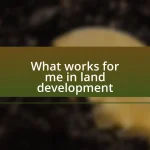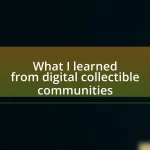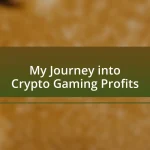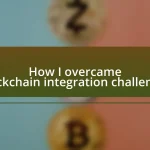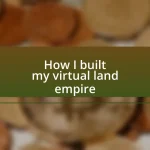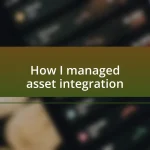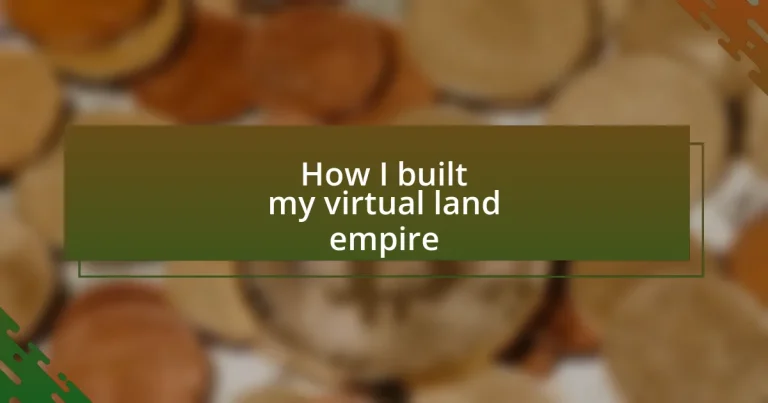Key takeaways:
- Virtual land is akin to digital real estate, with value influenced by community engagement and creativity.
- Choosing the right platform involves considering user base, customization options, market trends, ease of use, and transaction costs.
- Effective acquisition strategies include scouting undervalued areas, networking with industry players, and analyzing market trends.
- Monetization strategies like renting spaces, securing sponsorships, and creating sellable experiences can enhance revenue from virtual properties.
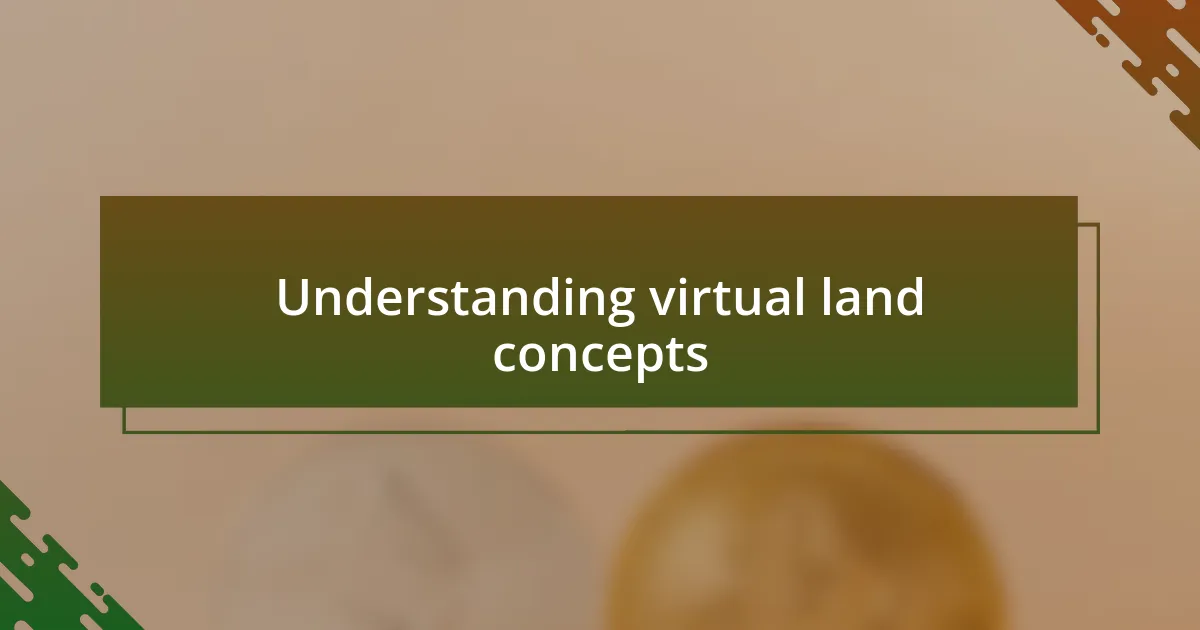
Understanding virtual land concepts
When diving into the world of virtual land, it’s crucial to grasp what virtual land really is. Picture this: a digital plot that exists within a vast online environment, much like a piece of real estate in the physical world. I remember when I first stumbled upon this concept; it felt surreal to think that land, which I had always associated with tangible resources, could have its worth and value in a virtual space.
Understanding the distinctions between types of virtual land can deepen your appreciation for this digital frontier. For example, some platforms prioritize user-generated content, like Decentraland, where you can create anything your imagination allows. When I began exploring these platforms, the thrill of designing my own virtual experiences taught me how vibrant and dynamic these spaces can be.
Have you ever wondered how virtual land can appreciate like real estate? The answer lies in community engagement and creativity. I learned this firsthand when a small initial investment in a less-populated virtual area blossomed into a thriving hub after I collaborated with others to build unique attractions. This transformative experience opened my eyes to the potential that virtual land holds—not just as an investment, but as a space for connection and innovation.
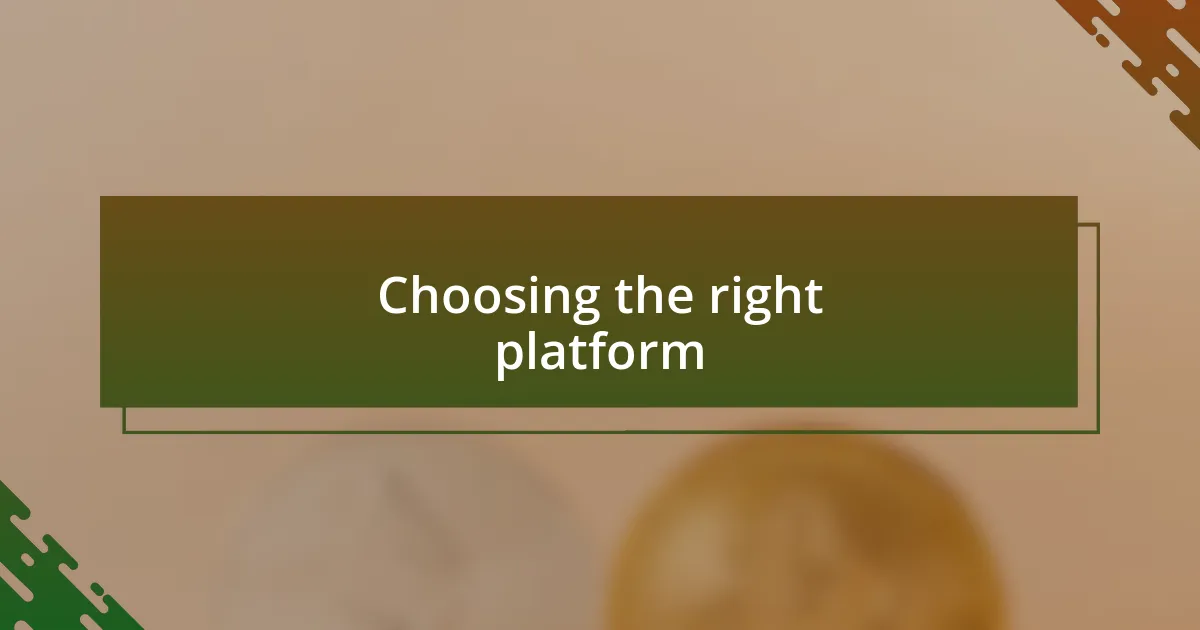
Choosing the right platform
Choosing the right platform can make or break your virtual land experience. When I first started out, I found myself overwhelmed by the sheer number of options available. My decision was based not just on the platform’s popularity, but also on the kind of community I wanted to be a part of and the tools I expected to use in creating my virtual space.
Here are some factors to consider when selecting a platform:
- User Base: Look for platforms with an active community. A vibrant user base can provide opportunities for collaboration and engagement.
- Customization Features: Ensure the platform allows you to customize your land. Creative freedom is essential for building something unique.
- Market Trends: Investigating the platform’s growth trajectory can reveal potential for future value appreciation.
- Ease of Use: Some platforms have a steep learning curve. Choose one that matches your technological comfort level.
- Transaction Costs: Don’t overlook the fees associated with buying, selling, or developing virtual land. A lower cost might initially seem attractive, but frequent fees can add up.
Ultimately, finding a platform that aligns with your vision and goals can enhance your entire experience in the virtual land world. I remember feeling a sense of relief when I finally picked a platform that resonated with my creative aspirations and allowed me to connect with like-minded individuals. It felt like unlocking a door to limitless possibilities.
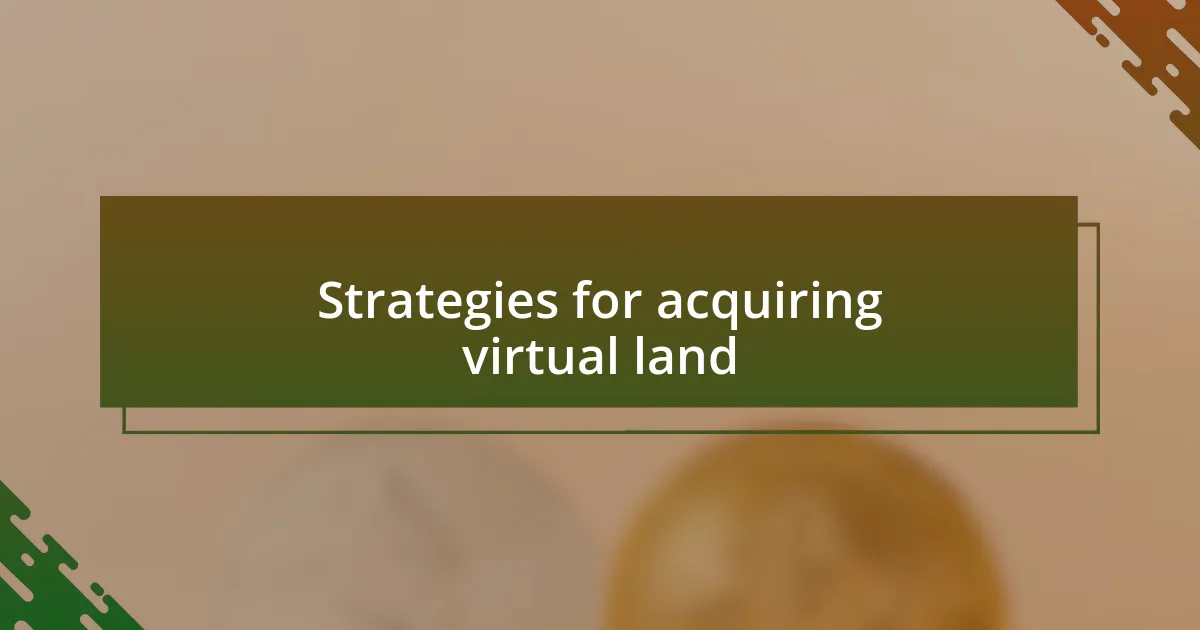
Strategies for acquiring virtual land
Acquiring virtual land requires a blend of strategic thinking and inspired action. One approach I’ve found effective is scouting for undervalued areas within established platforms. After all, I vividly recall the thrill of purchasing a plot that others overlooked, only to see its value soar as interest in that region grew. Such opportunities often require patience and a keen sense of market timing.
Another strategy involves networking with other landowners and industry players. I remember attending virtual meetups, where exchanging ideas with fellow enthusiasts not only broadened my understanding but also led to lucrative partnerships. Building relationships within the community can provide insider knowledge about potential land deals before they hit the market.
Lastly, keeping a close eye on market trends can guide your acquisition strategies. I often analyze market reports or follow influential figures in the virtual land space. By staying updated, I can make informed decisions about which plots are likely to appreciate. This approach has kept my investment strategy dynamic and attuned to shifts in virtual land demand.
| Strategy | Description |
|---|---|
| Scouting Undervalued Areas | Look for locations that are not popular but have growth potential. |
| Networking | Engage with others in the community to gain insights and opportunities. |
| Market Trend Analysis | Stay informed about market developments to identify promising acquisitions. |
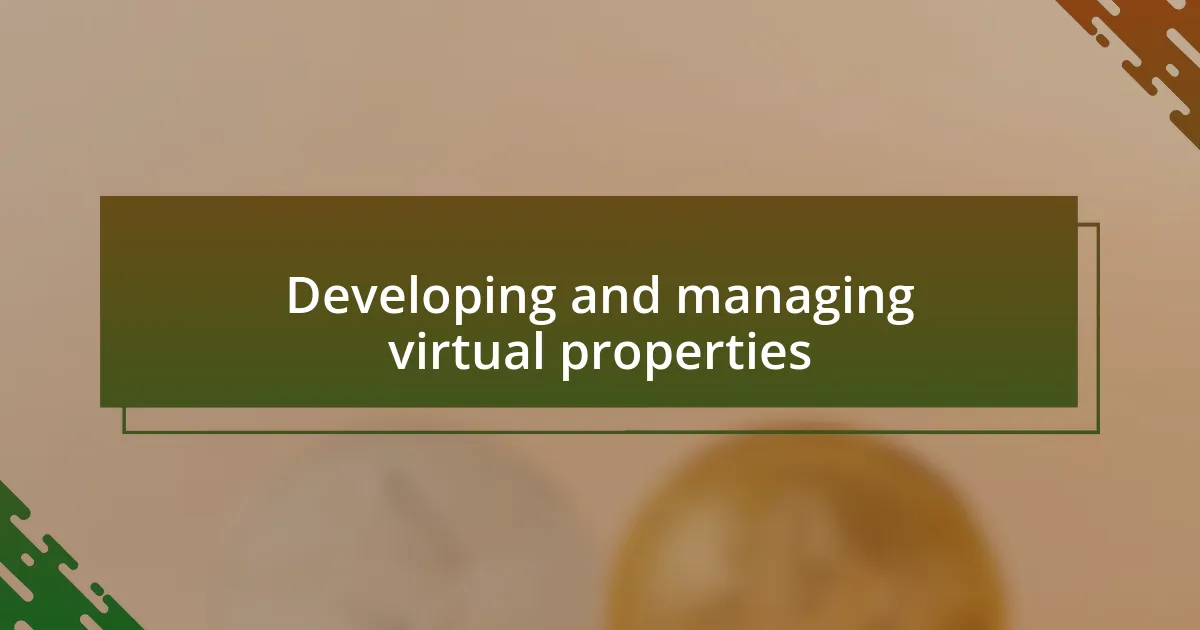
Developing and managing virtual properties
To successfully develop virtual properties, I’ve learned the importance of crafting unique and engaging experiences. I still remember the first time I customized a space in a popular metaverse, adding imaginative features that turned a bland lot into a vibrant community hub. Isn’t it rewarding when your vision comes to life, attracting visitors and creating a buzz?
Managing virtual properties requires continuous engagement with your audience. I’ve experimented with hosting events on my land—these gatherings not only entertain but also cultivate a loyal following. Reflecting on my early attempts, I noticed how small changes in layout or event themes drastically influenced attendance and enthusiasm. It’s a fascinating dance between creativity and analytics.
Regularly assessing the value of my virtual properties has become crucial. I often find myself revisiting past purchases to gauge their worth in the current market. Every time I recalibrate my portfolio, it’s like rediscovering hidden treasures. How do you ensure your investments remain relevant amidst ever-changing trends? For me, it’s about balancing personal passion with strategic foresight, ensuring each property reflects both my unique style and the evolving landscape of the virtual world.
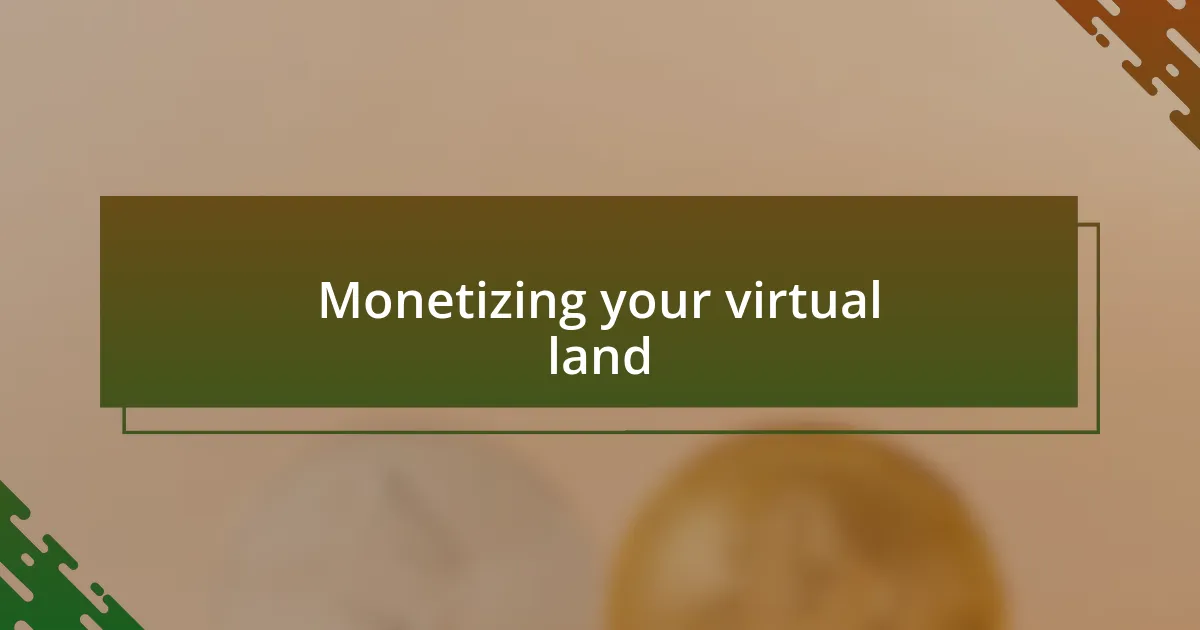
Monetizing your virtual land
Monetizing virtual land can be an exhilarating venture, and I’ve discovered a few key strategies that work wonders. One of my most successful experiences has been renting out spaces for events; the thrill of watching my plot come alive with eager participants and engaging activities is incomparable. Have you ever hosted a gathering that just took off? It’s electrifying, and the rental fees often cover my initial investment and then some.
Sponsorships have also turned out to be a game-changer for me. I once partnered with a virtual brand that aligned perfectly with my audience’s interests. Just seeing my land adorned with their products brought a sense of pride, not to mention the steady stream of passive income that followed. It’s a reminder that connecting with the right brands can create a win-win situation.
Lastly, I can’t stress enough the potential of creating unique experiences that can be sold for entry fees. I vividly recall organizing an art exhibit in my virtual space. Guests were charged a small fee to enter and explore stunning digital artwork. The buzz from social media not only drew attention but also allowed me to collaborate with artists, further enriching the experience. It’s moments like these that make you realize how innovative ideas can truly transform a piece of virtual land into a thriving business.
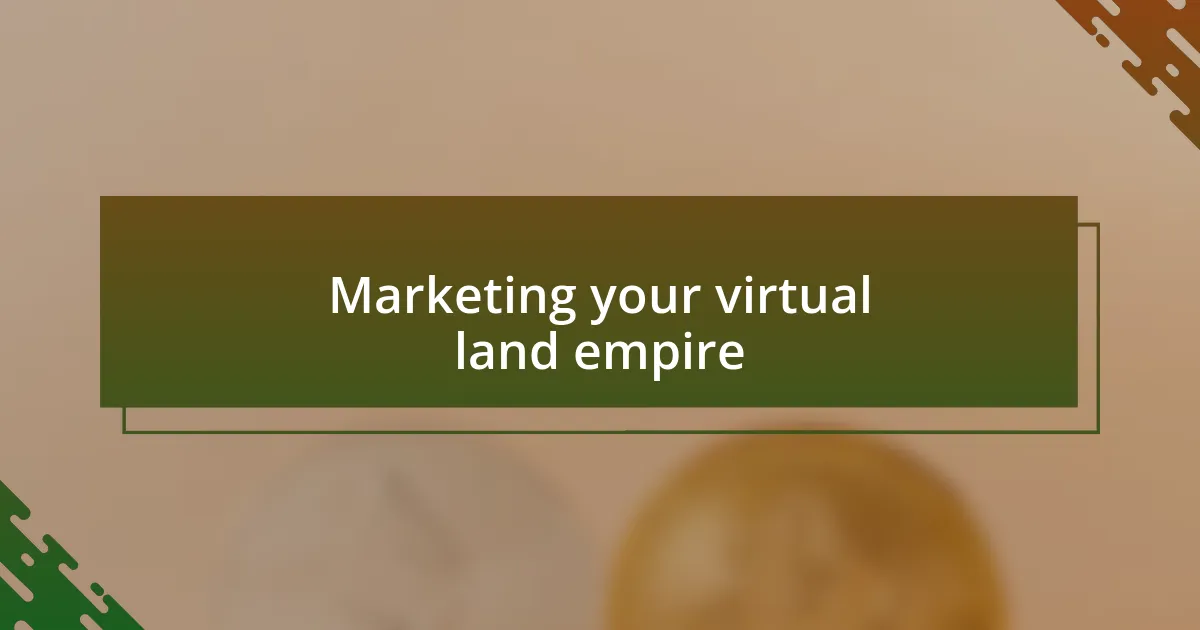
Marketing your virtual land empire
Marketing your virtual land empire requires a strategic approach that can amplify your reach and attract the right audience. I remember the excitement of launching a targeted social media campaign, where I showcased not just the space, but the experiences that came with it. It’s fascinating how a visually appealing post can spark curiosity and conversations—have you ever noticed the power of a good story behind a picture?
Another effective method I’ve used is collaborating with influencers who share a passion for virtual spaces. In one instance, I teamed up with a popular content creator who hosted a live tour of my virtual land. The boost in visibility was remarkable. It’s intriguing how the right voice can add authenticity and draw a crowd—have you considered how partnerships can broaden your marketing reach?
Additionally, tapping into niche communities on platforms like Discord or Reddit has proven invaluable. Sharing insights and engaging in discussions about virtual land has not only built credibility but has also fostered genuine connections. I’ve discovered that when you share your journey openly, you invite others to join in, which often leads to unexpected collaborations and opportunities. Isn’t it rewarding to see your virtual land empire grow through community support?


